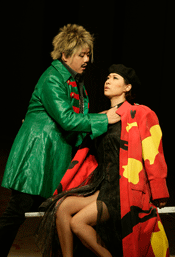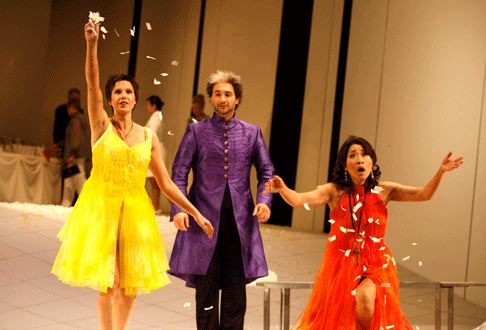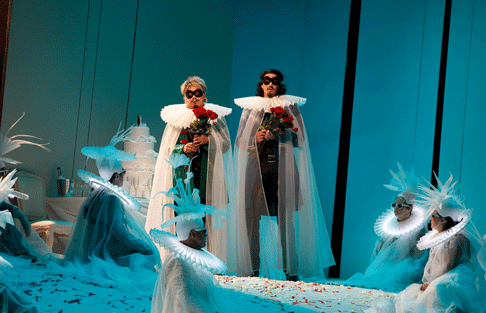24 Nov 2009
Così fan tutte, Opera Australia
Like most opera companies, the Mozart/da Ponte trifecta of Figaro, Don Giovanni and Così fan tutte are central to Opera Australia’s repertoire.

Like most opera companies, the Mozart/da Ponte trifecta of Figaro, Don Giovanni and Così fan tutte are central to Opera Australia’s repertoire.
Like his production of Don Giovanni, the staging of Così fan tutte by the late Göran Järvefelt served the company well for decades before being replaced in September by this new take on the story by Jim Sharman. Sharman is one of Australia’s most invigorating stage directors whose earliest work was with Opera Australia (then called The Australian Opera) when, in 1967, as a twenty-one year old, he produced Don Giovanni, setting it on a huge chess board and calculating the Don’s progress to Hell like chess strategies. Sharman’s biggest claim to worldwide fame, however, is as director of the original The Rocky Horror Show and it’s subsequent film adaptation. In Australia he now counted among the country’s foremost directors with laudable stagings of classic and contemporary plays, musicals and occasionally operas. His staging of Britten’s Death in Venice was mounted for the 1980 Adelaide Festival, barely five after it’s premiere where it garnered favourable comments from local and international critics before being taken into Opera Australia’s repertoire where it still holds sway nearly thirty years later.
Like than early Don Giovanni, Sharman’s Così fan tutte sadly seems to be trying too hard. But by most accounts Così is a difficult opera to pull off. The partner swapping shenanigans and misogynist sentiment have stranded it as a kind of antiquated boulevard farce like Georges Feydeau set to music!
 Henry Choo (Ferrando) and Hye Seoung Kwon (Fiordiligi)
Henry Choo (Ferrando) and Hye Seoung Kwon (Fiordiligi)
Using a contemporary setting, Sharman reveals during the overture a wedding
party, the couple, a Japanese Bride and Groom, arriving at the reception before
freezing the action and transporting the Bride and Groom to either side of the
stage where they watch the opera unfold before being transported back at the
end of the opera to their nuptials as the cast sing the opera’s moral.
Don Alfonso’s (José Carbó) bet appears to be a the result of a locker
room brag as Ferrando (Henry Choo) and Guglielmo (Luke Gabbedy), under stylised
showers, compare their respective fiancée’s virtue (rather, as one would
imagine in a locker room situation, their physical or sexual attributes). The
action unfolds in a white walled set, designed by Ralph Myers, with an arched
floor where the stranded wedding organisers and guests act as chorus and
occasional prop movers. Occasionally the wedding photographer appears with a
live video camera to zoom in on characters during their principal arias and
relay their image to a huge curtain interminably pulled back and forth
throughout the long opera.
While the concept may be puzzling it works well enough until the second act where these directorial high jinks gloss over the searing bitterness as Fiordiligi (Hye Seoung Kwon) agonises over her situation and the two men agonise over the swiftness of their lovers infidelity. Unlike Brad and Janet in Sharman’s notorious The Rocky Horror Show, the partner swapping and sexual humiliation is far from funny. In fairness the fault lies with the opera itself it’s sexual attitudes are as infuriating to modern audiences as those of Shakespeare’s The Taming of the Shrew and even the best directors have a tough job with either.
 Sian Pendry (Dorabella), José Carbó (Don Alfonso) and Hye Seoung Kwon (Fiordiligi)
Sian Pendry (Dorabella), José Carbó (Don Alfonso) and Hye Seoung Kwon (Fiordiligi)
The opera is also sung in a modern English translation by Jeremy Sams that almost matches the famous, mid-twentieth century, Ruth and Thomas Martin translation for its lumpiness. While getting plenty of laughs for its up to date casualness (“I might forget myself or even wet myself” sing the men after Guglielmo’s ‘mustacchi’ serenade sends the ladies packing), Sams’s choice of words robs the open-vowelled flow of da Ponte’s Italian text. Nor does Sams even try to be literal about translating the original words, let along consider their singability “I have sinned my best beloved” is his substitution for Fiordiligi’s “per pieta, ben mio perdona”. Sams even suggests that the opera's ‘motif’’ “Così fan tutte”, when sung by Don Alfonso should be “That’s how God made them”. If an opera company must perform a work in translation (and spend good money on royalties for it) it should at least be better than this.
To their credit, the young cast sing even the most difficult passages clearly; nearly every word of the unfortunate text is audible. Henry Choo is a most stylish tenor; his voice has the heft to carry into the big auditorium without apparent force. He establishes a beautiful and limpid line through ‘Un’aura amorosa’ and is spot-on in the difficult runs in the act one finale. As Guglielmo, Luke Gabbedy’s light baritone could almost be mistaken for a tenor and a darker colour might be wished for in the duet with Dorabella (Sian Pendry) and the act two aria. The same applies to José Carbó’s as Alfonso, the voice seeming lighter than one would expect for the role. Of the ladies the most accomplished is Tiffany Speight as Despina. Speight is one of the company’s best Mozartians, her voice is silvery, carries effortlessly and her charming stage presence carries with the same clarity. Hye Seong Kwon handled Fiordiligi’s big moments with breathtaking ease, long phrases, octave jumps and embellishments all perfectly judged despite the impositions the English words placed on her. Sian Pendry handled Dorabella’s music with similar ease; hers is a high, light mezzo, rather like Gabbedy’s high, light baritone. Kwon and Pendry also make their first appearance in swim suits and spend the rest of the opera equally revealing costumes and both have catwalk figures.
 Henry Choo (Ferrando) and Luke Gabbedy (Guglielmo)
Henry Choo (Ferrando) and Luke Gabbedy (Guglielmo)
Ollivier-Philippe Cunéo coaxed a period sounding performance from the orchestra, the strings occasionally emphasising that wiry sound that passes for authentic. Cunéo also adopts that peculiar practice of breathlessly playing the two opening chords of the overture (as evidenced in Arnold Östman's 1986 recording of the opera) and generally rushing things where a little restraint might have been better. The woodwind were often given a difficult time and the big moment when Fiordiligi finally succumbs (Mozart’s delectably sudden change from lurching chords to gorgeous runs on the strings) passed without the attention it deserves.
With chick costumes and attractive singers to wear them, this Così will certainly appeal to younger audiences. Sharman is obviously at his best when dealing amorous absurdities but the deeper musical and emotional content that is so unique in the Mozart/da Ponte operas are left buried.
Michael Magnusson